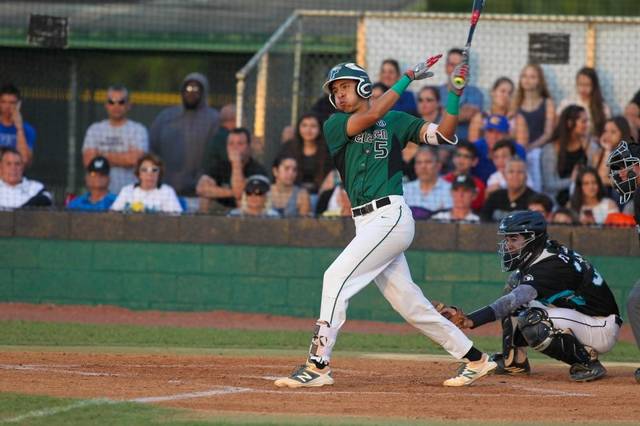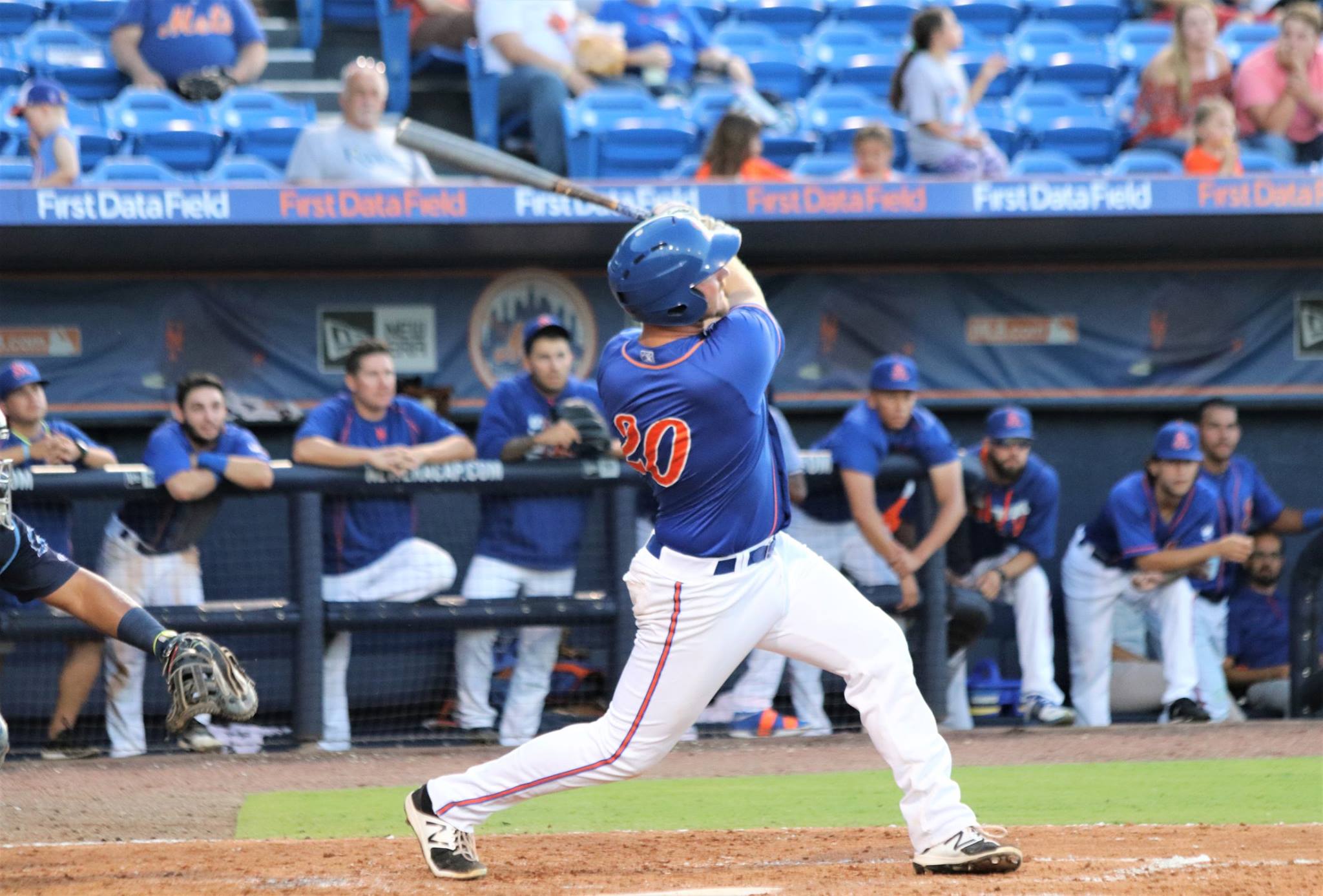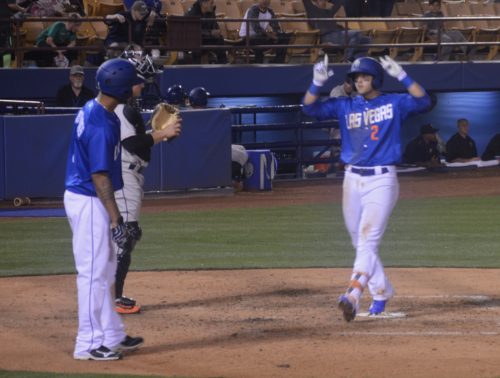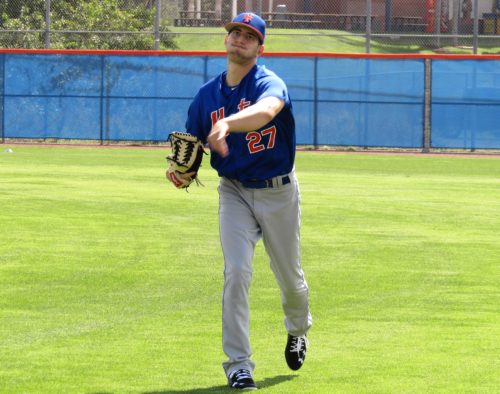
10. INF Mark Vientos
Ht: 6’4″ Wt: 185 lb Level: Gulf Coast
B/T: R/R Age: 12/11/99 (17) Age Dif: -2.4
Acquired: 2017 second round draft pick from American Heritage High School (Plantation, FL)
Previous Rank: N/A
2017 Stats: 30 G, 120 PA, 109 AB, 12 R, 24 H, 7 2B, HR, 13 RBI, CS, .220/.292/.312
Profile: Coming out of the draft, Vientos was seen as one of the most promising prep bats. He’s shown quick hands, good bat speed, and an ability to drive the ball. With him being one of the younger players in the draft class and his not yet fully maturing, there is promise for him to hit for even more power. For that to happen, he’s going to have to also get stronger.
His maturity could also be an issue for him. In high school, Vientos played shortstop, but he will have to move off of the position sooner rather than later. At the moment, the reason is Vientos has below-average speed, and as a result, range for the position. As Vientos matures the things that compromises his ability to play will become an even bigger issue.
Still, Vientos has good hands and a strong arm which would suggest he could stick at third base. That’s important for a Mets organization without a real outstanding third base prospect. If Vientos doesn’t show an ability to play third, his bat does projects to be good enough to profile at a corner outfield spot.

(Ed Delany/Mets Minors)
9. 1B Peter Alonso
Ht: 6’3″ Wt: 225 Level: St. Lucie
B/T: R/R Age: 22 (December 7, 1994) Age Dif: -0.8
Acquired: Drafted in Round 2 (#64) in 2016 from University of Florida
Previous Rank: 12
2017 Stats: 68 G, 287 AB, 38 R, 74 H, 20 2B, 14 HR, 52 RBI, 2 SB, 4 CS, .291/.369/.535
Profile: From the very moment Alonso joined the Mets organization, he has shown the ability to hit and hit for power. In fact, last year, he impressed so much with his .587 slugging percentage, which would have led the league if he qualified, he was named a New York Penn League All Star despite having played in just 30 games. Based on the strength of that season, Alonso skipped Columbia, and he was assigned to St. Lucie to begin the year.
After an adjustment period and some injuries healing, Alonso is back to destroying baseballs. Since the beginning of June, Alonso is hitting .322/.404/.584 with 20 doubles, 12 homers, and 48 RBI. This is largely the result of Alonso showing good pitch recognition and the ability to generate power from the lower half of his body. However, he does have some holes in his swing with his tendency to overswing at times and pull off the ball. That does limit his ability to reach the ball at the outer half. With that said, when he’s in a groove like he is now, he hits everything, and he hits tape measure shots.
Despite the power, it is difficult at the moment to envision him supplanting Dominic Smith as the Mets first baseman of the future.
The biggest issue with Alonso is his defense. While he has previously played third base, he no longer has the athleticism to handle that position. In fact, based upon what we have seen from this year, there may be issues about his ability to stick at first base. While fielding percentage and errors are not the best way to measure a player’s defense, Alonso’s .972 fielding percentage and 15 errors serve as cause for alarm.
With a bat like Alonso’s, teams will always find a spot for him to play. Certainly, we have seen the Mets do it in the past playing Lucas Duda in the outfield. For that to even be a consideration for Alonso, he’s going to have to put in a lot of work in the offseason to make that a possibility. For that matter, Alonso is going to have to put in a lot of work to become someone the Mets would feel comfortable playing first base at the major league level.

8. 2B/SS Gavin Cecchini
Ht: 6’2″ Wt: 200 Level: AAA & MLB
B/T: R/R Age: 12/22/93 (23) Age Dif: -3.4
Acquired: Selected in the first round (12th) of the 2012 Amateur Draft
Previous Rank: 7
2017 MiLB Statistics: 102 G, 458 PA, 418 AB, 61 R, 110 H, 25 2B, 2 3B, 5 HR, 34 RBI, 4 SB, 4 CS .263/.325/.368
2017 MLB Statistics: 5 G, 14 PA, 14 AB, R, 4 H, HR, 2 RBI, .286/.286/.500
Profile: With Amed Rosario being promoted to Triple-A to start the season, Cecchini finally made the move to second base. Defensively, Cecchini has found a home at second base. It is a position he has plus range and arm strength. More than that, gone are the errors and mental mistakes he made while he was a shortstop. With his play at second base and Neil Walker‘s impending free agency, he has made a case he should be considered the Mets second baseman next year.
Unfortunately, it does not seem that will be the case because Cecchini has not been the hitter he showed he was last year.
Last year, he hit .325/.390/.448 in Triple-A, and he followed that by hitting .295/.357/.459 in the Arizona Fall League. During the season, and for much of his minor league career, he has shown an advanced approach at the plate. He is a patient hitter that works the count well and is willing to draw a walk. He is good at identifying his pitch and trying to drive it somewhere. He is a a line drive hitter with a gap-to-gap approach at the plate.
This season he has seen drops in both his BABIP and isolated power. The figures that were at .357 and .123 last year has dropped considerably to .295 and .105 this year. Before arguing the numbers he posted last year were unsustainable, it should be pointed out he had a .348 BABIP and .125 isolated power in the Eastern League, which is not the friendliest of hitting environments.
It should also be pointed out he was impressed in his brief big league appearance this year. He had a four game hitting streak, and he hit his first major league homer against Clayton Kershaw. More than the stats, Cecchini did not look intimidated by the level. Overall, he has made the case he can one day stick at the major league level.
The question right now is where he would play. The Mets appear destined to give others a shot ahead of him at second, and after Rosario’s call-up, Cecchini has moved back to short. At a minimum, the increased versatility will help him earn his next call-up. If he once again shows the Mets he is undaunted at the major league level, he may just stick.

Photo By Ernest Dove
7. RHP Justin Dunn
Ht: 6’2″ Wt: 185 Level: St. Lucie
B/T: R/R Age: 09/22/1995 (21) Age Dif: -2.1
Acquired: Drafted by the Mets in the 1st Round of the 2016 MLB Draft (19th overall)
Previous Rank: 6
2017 Stats: 5-6, 5.00 ERA, 20 G, 16 GS, 95.1 IP, 1.563 WHIP, 7.1 K/9
Profile: Coming out of college, there was doubt whether Dunn, who was primarily used as a collegiate reliever, would be able to stick in the rotation. However, with his repertoire and high ceiling, it was a worthy gamble.
Dunn is a good athlete who has good mechanics, does not throw with much effort, and tops out with 97 MPH. He already throws a good curve ball and slider with a developing change. While the breaking pitches still needs work, it is the change-up that needs the most work. Regardless of his stuff not being fully developed, he flashed some of his potential in what was a good debut in Brooklyn. During that debut, former Cyclones manager gave him one of the highest honors someone could give a Mets prospect by comparing him to Dwight Gooden.
Based on what Dunn showed the Mets last year, the team was aggressive with him, and they promoted him to St. Lucie.
During this season, Dunn has had a season that has caused the concerns about his ability to stick in the rotation to resurface. Part of the reason is his secondary pitches are not quite where they need to be. With that said, we have seen pitchers be able to perform well at this level of the minors with one plus pitch. That goes to the real issue with Dunn. So far this season, he has had difficulty repeating his delivery over the course of the game, and after having spent such a long time as a reliever, his stamina is not quite where it needs to be. It goes a long way to explaining why he has a 5.74 ERA and 1.723 WHIP as a starter this year.
Further compounding matters was Dunn’s stint in the bullpen this year. Dunn was moved to the bullpen briefly to help him adjust after a tough start to the season. In that stretch, he had a 1.59 ERA and 0.824 WHIP in four relief appearances. The stark contrast between his starting and relief stats will only lead credence to the argument he belongs in the bullpen.
However, calls for him to go to the pen are premature. This is his first full season as a starter, and there is going to be a necessary period of adjustment. He deserves and is going to get an opportunity to learn from this experience and improve his secondary pitches, mechanics, and stamina. If and when that happens, the Mets will have a promising front end starting pitcher.

6. LHP Thomas Szapucki
Ht: 6’2″ Wt: 205 Level: Columbia
B/T: R/L Age: 06/12/1996 (21) Age Dif: -0.9
Acquired: Drafted by the Mets in the 5th Round of the 2015 MLB Draft (149th overall pick)
Previous Rank: 4
2017 Stats: 1-2, 2.79 ERA, 6 G, 6 GS, 29.0 IP, 1.172 WHIP, 8.4 K/9
Profile: More than any pitcher in the Mets farm system, Szapucki seemed to be on an upward trajectory. He showed off a sweeping curveball that was tough on lefties and righties alike. However, it wasn’t just the curveball. He increased velocity on his fastball where it was now routinely sitting in the mid-90s. With him quickly developing a change-up, it seemed like he had that third pitch that could make him a top of the rotation starter.
It’s why he was able to completely dominate the opposition in 2016, and it was a reason why he received a Sterling Award last year. His assignment to Columbia this season looked like it was going to be a brief spot. As it turns out, it was but for the wrong reason.
Szapucki would initially miss the start of the season with a shoulder impingement, and he would leave a July 7th start with left forearm discomfort. Ultimately, Szapucki was injured, and he would undergo Tommy John surgery. Based upon the timeline we have seen with other Mets starters, it is likely we will not see Szapucki pitch again until 2019. When he comes back, we will hopefully see him resume his trajectory towards being a top of the rotation starter.
EDITOR’S NOTE: These rankings have been updated to reflect changes that have occurred in the Mets minor league system since the trade deadline.
PREVIOUS RANKINGS:
15 – 11 Led by Desmond Lindsay

